Experiments on Longitudinal and Transverse Bedload Transport in Sine-Generated Meandering Channels
Abstract
1. Introduction
2. Experimental Setup and Measurements
3. Results
3.1. The 110° Flume
3.2. The 30° Flume
3.3. Accumulated Sample Volume of the Colored Grains
3.4. Point Bar Composition
4. Implication and Discussion
5. Summary and Conclusions
- (1)
- Two types of erosion zone occurred during the process of the bed deformation, i.e., Zone 1 in the foreside of the point bars and Zone 2 near the concave bank downstream of the bend apexes.
- (2)
- Most grains eroded from both Zone 1 and Zone 2 are observed moving longitudinally as opposed to crossing the channel centerline. The ratios of eroded D1 grains from the B1 bend who were longitudinally transported to the next bend B2 were 71% for the 30° flume and 72% for the 110° flume. The ratios of the D2 grains eroded from the B1 bend who were longitudinally transported to the next bend B2 were 90% for the 30° flume and 86% for the 110° flume.
- (3)
- Most building material of the point bars comes from the upstream bends, although low- and highly curved channels behave differently. For building material of the B2 bend point bars, the contribution ratios of grains coming from upstream bend were 87% for the 30° flume and 73% for the 110° flume.
Author Contributions
Funding
Institutional Review Board Statement
Informed Consent Statement
Data Availability Statement
Conflicts of Interest
References
- Qian, N.; Zhang, R.; Zhou, Z.D. Fluvial Evolution; Science Press: Beijing, China, 1987. [Google Scholar]
- Dietrich, W.E.; Smith, J.D.; Dunne, T. Flow and sediment transport in a sand bedded meander. J. Geol. 1979, 87, 305–315. [Google Scholar] [CrossRef]
- Zeng, Q.H. The movement of bedload in bend river. J. Sediment Res. 1982, 59–65. [Google Scholar] [CrossRef]
- Lajeunesse, E.; Devauchelle, O.; Houssais, M.; Seizilles, G. Tracer dispersion in bedload transport. Adv. Geosci. 2013, 37, 1–6. [Google Scholar] [CrossRef][Green Version]
- Kasvi, E.; Laamanen, L.; Lotsari, E.; Alho, P. Flow patterns and morphological changes in a sandy me ander bend during a flood-spatially and temporally intensive ADCP measurement approach. Water 2017, 9, 106. [Google Scholar] [CrossRef]
- Leopold, L.B. Water surface topography in river channels and implications for meander development. In Gravel-Bed Rivers; Hey, R.D., Bathurst, J.C., Thorne, C.R., Eds.; John Wiley Sons Ltd.: Hoboken, NJ, USA, 1988; pp. 359–388. [Google Scholar]
- Friedkin, J. A Laboratory Study of the Meandering of Alluvial Rivers; Technical Reports; U.S. Waterways Experiment Station: Vicksburg, MS, USA, 1945. [Google Scholar]
- Rui, D.F. Numerical Model for Circumfluence and Movement of Sediment in Continuous Meandering River. Ph.D. Thesis, Sichuan University, Chengdu, China, 2005. [Google Scholar]
- Wang, B. Experiments of Water Flow and Bed Deformation in a Flume with Consecutive Curves; Tsinghua University: Beijing, China, 2008. [Google Scholar]
- Wang, P.Y.; Zhao, S.Q.; Cai, J.D. A study on the belt of bedload transport in sinuous channel. J. Sediment Res. 1995, 2, 43–48. [Google Scholar]
- He, L.; Chen, D.; Jia, Y.F.; Zhang, Y.X. Modeling bedload transport along river meanders. J. Hydroelectr. Eng. 2016, 35, 54–60. [Google Scholar]
- Termini, D. Experimental Observations of Flow and Bed Processes in Large-Amplitude Meandering Flume. J. Hydraul. Eng. 2009, 135, 575–587. [Google Scholar] [CrossRef]
- Zhang, R.J.; Xie, B.L. Study on river meander laws. In Proceedings of the 1st International Symposium on River Sedimentation, Beijing, China, 24–29 March 1980. [Google Scholar]
- Heays, K.G.; Friedrich, H.; Melville, B.W. Laboratory study of gravel-bed cluster formation and disintegration. Water Resour. Res. 2014, 50, 2227–2241. [Google Scholar] [CrossRef]
- Fredj, E.; Carlson, D.F.; Amitai, Y.; Gozolchiani, A.; Gildor, H. The particle tracking and analysis toolbox (PaTATO) for matlab. Limnol. Oceanogr. Methods 2016, 14, 586–599. [Google Scholar] [CrossRef]
- Parker, G.; Sawai, K.; Ikeda, S. Bend theory of river meanders. Part 2: Nonlinear deformation of finite-amplitude bends. J. Fluid Mech. 1982, 115, 303–314. [Google Scholar] [CrossRef]
- Blondeaux, P.; Seminara, G. A unified bar-bend theory of river meanders. J. Fluid Mech. 1985, 157, 449–470. [Google Scholar] [CrossRef]
- Termini, D. Momentum transport and bed shear stress distribution in a meandering bend: Experimental analysis in a laboratory flume. Adv. Water Resour. 2015, 128, 128–141. [Google Scholar] [CrossRef]
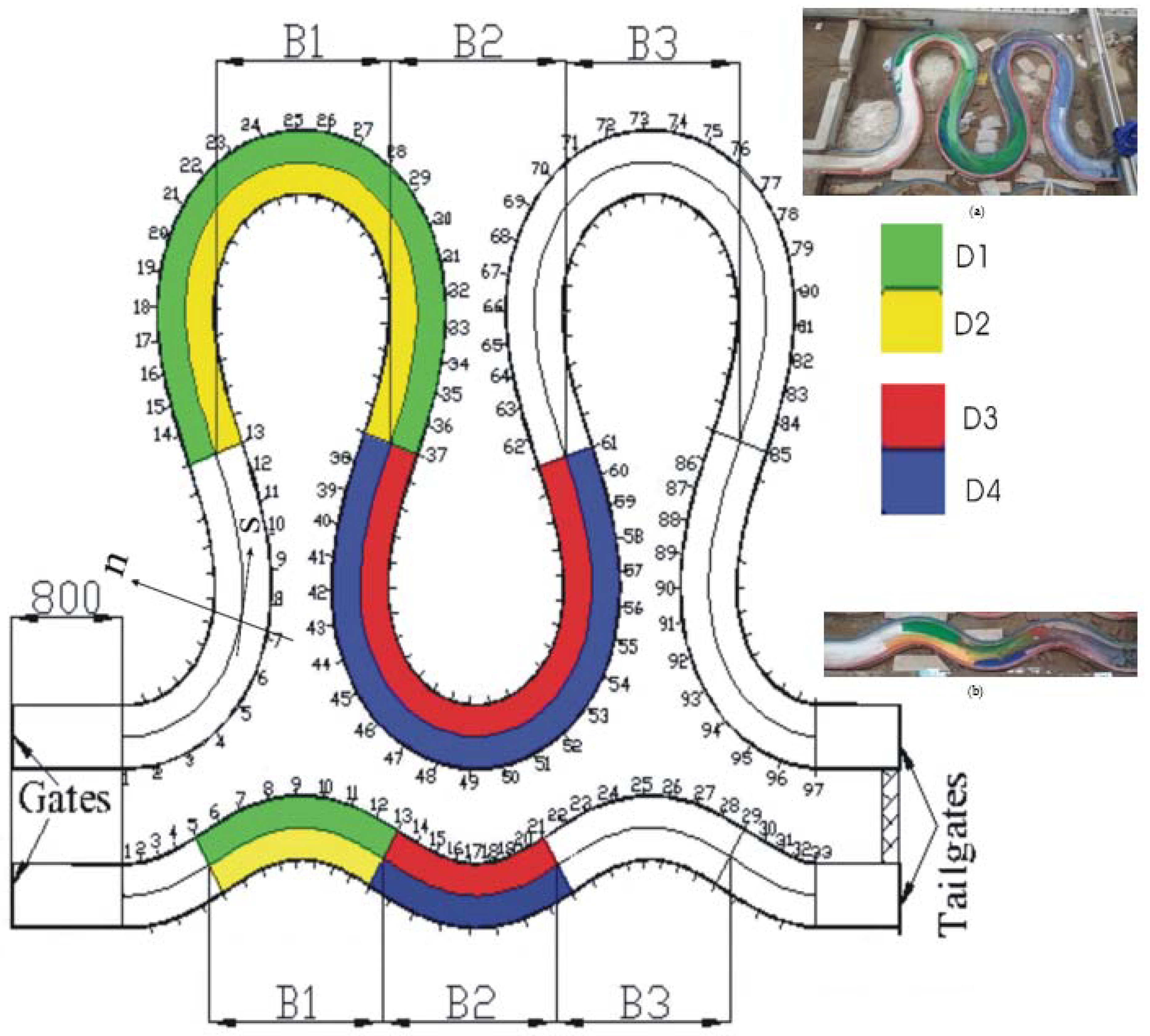
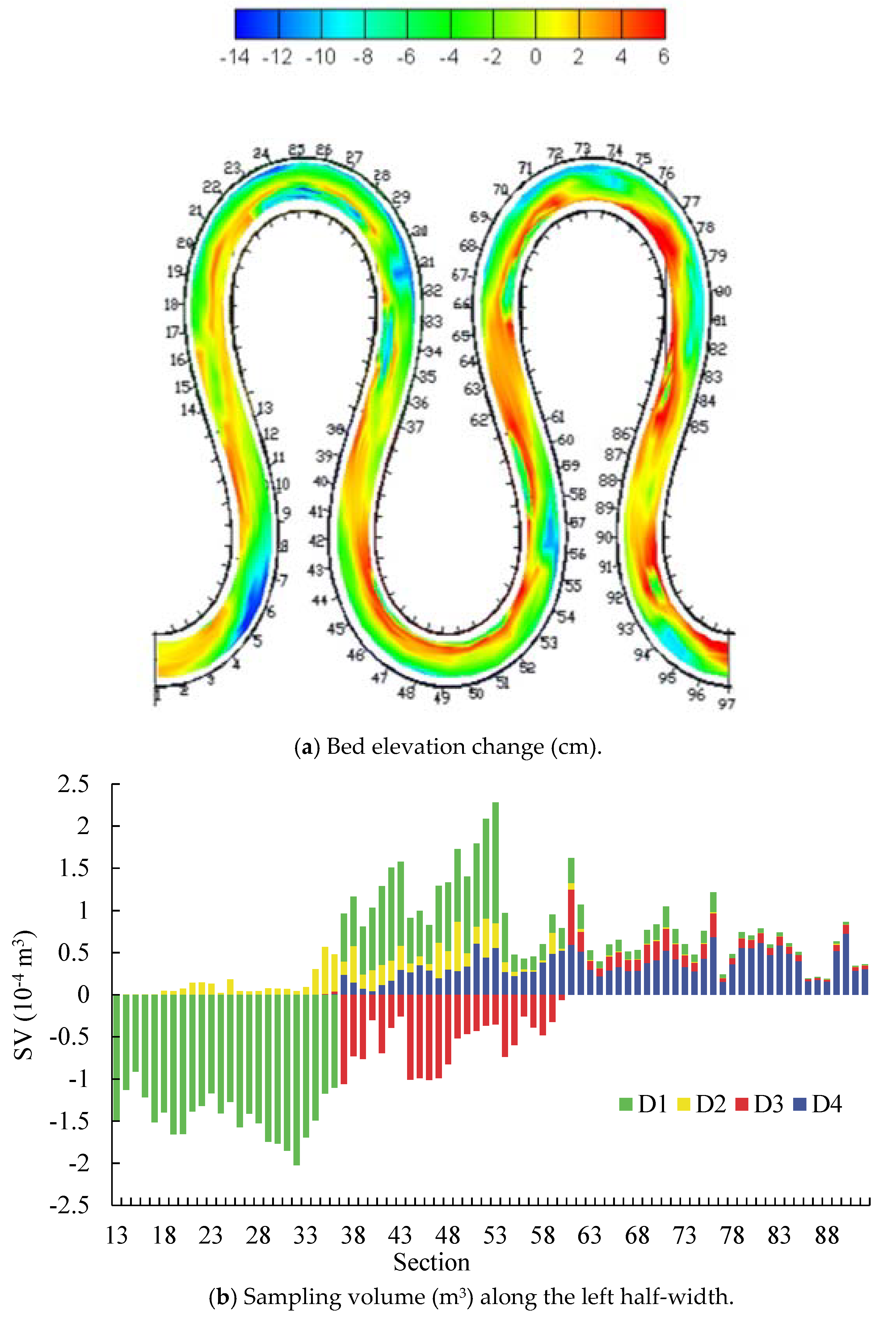
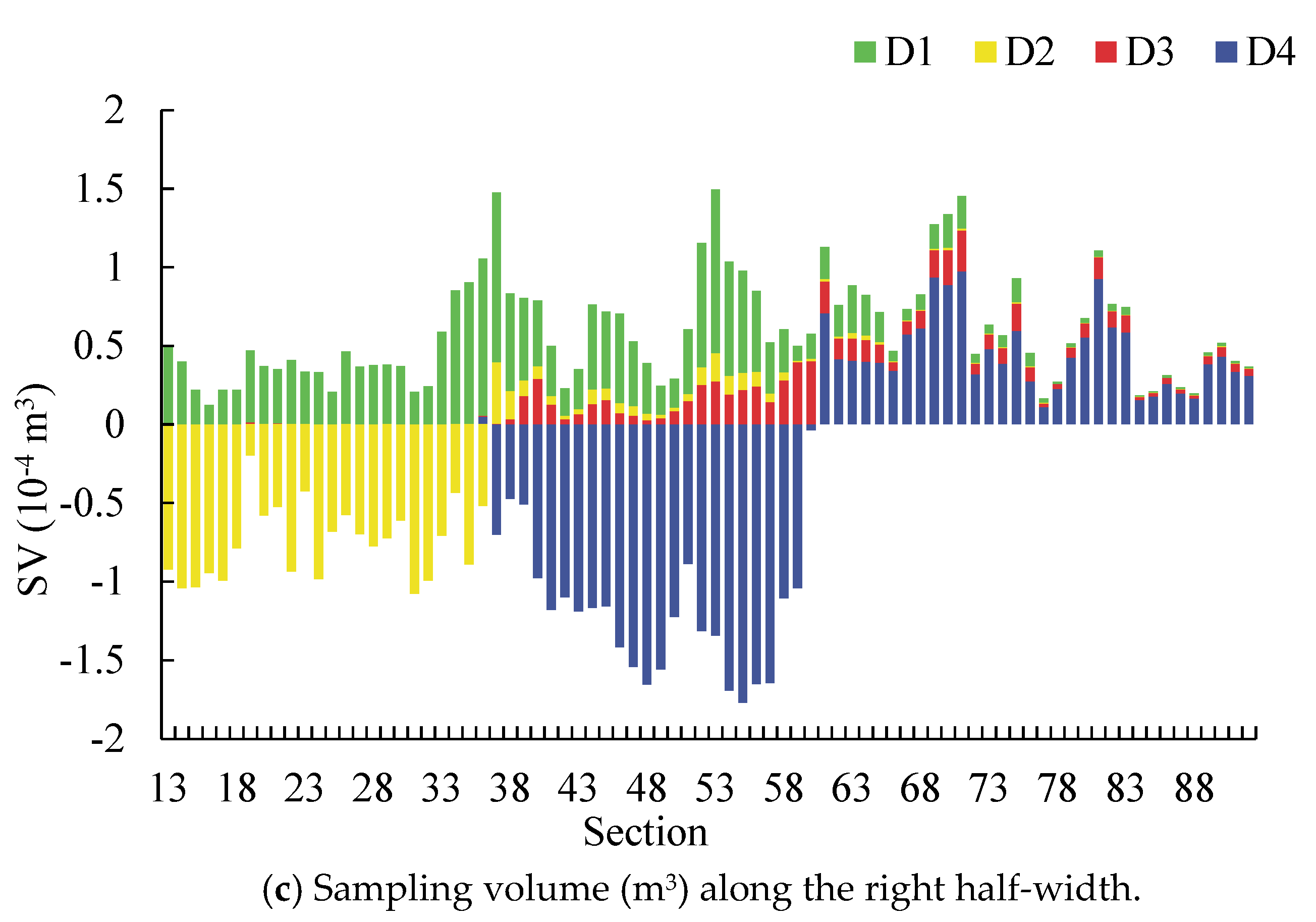
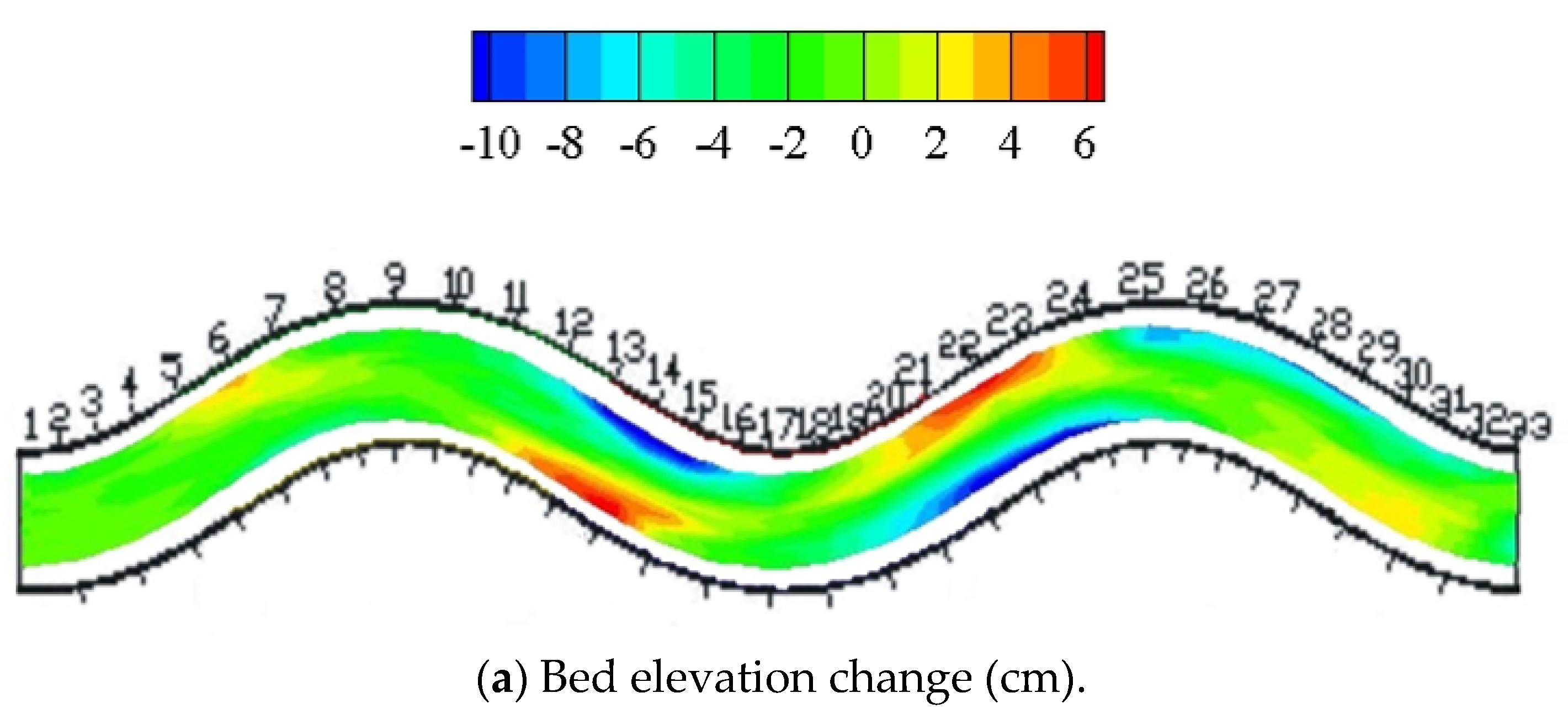
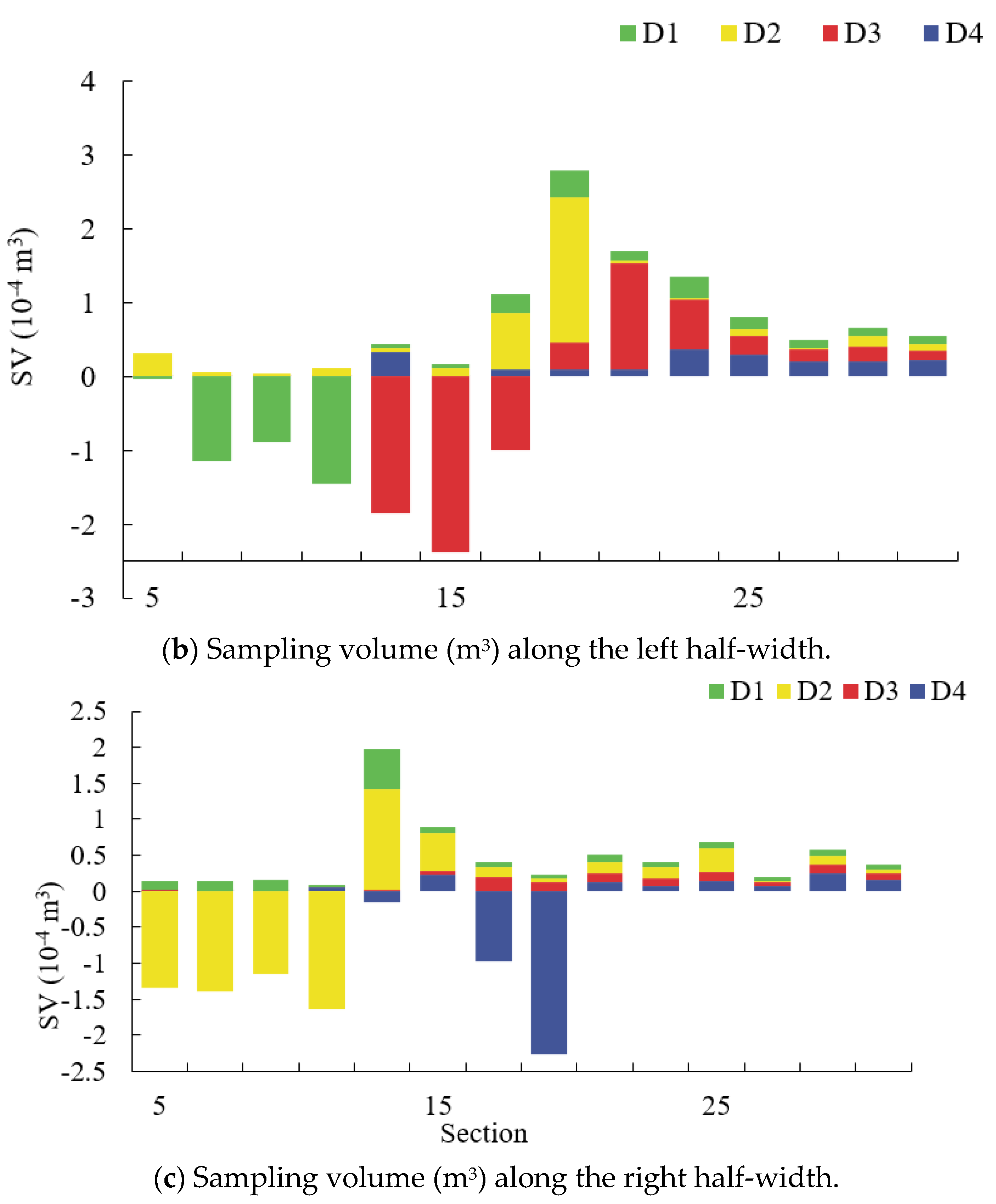
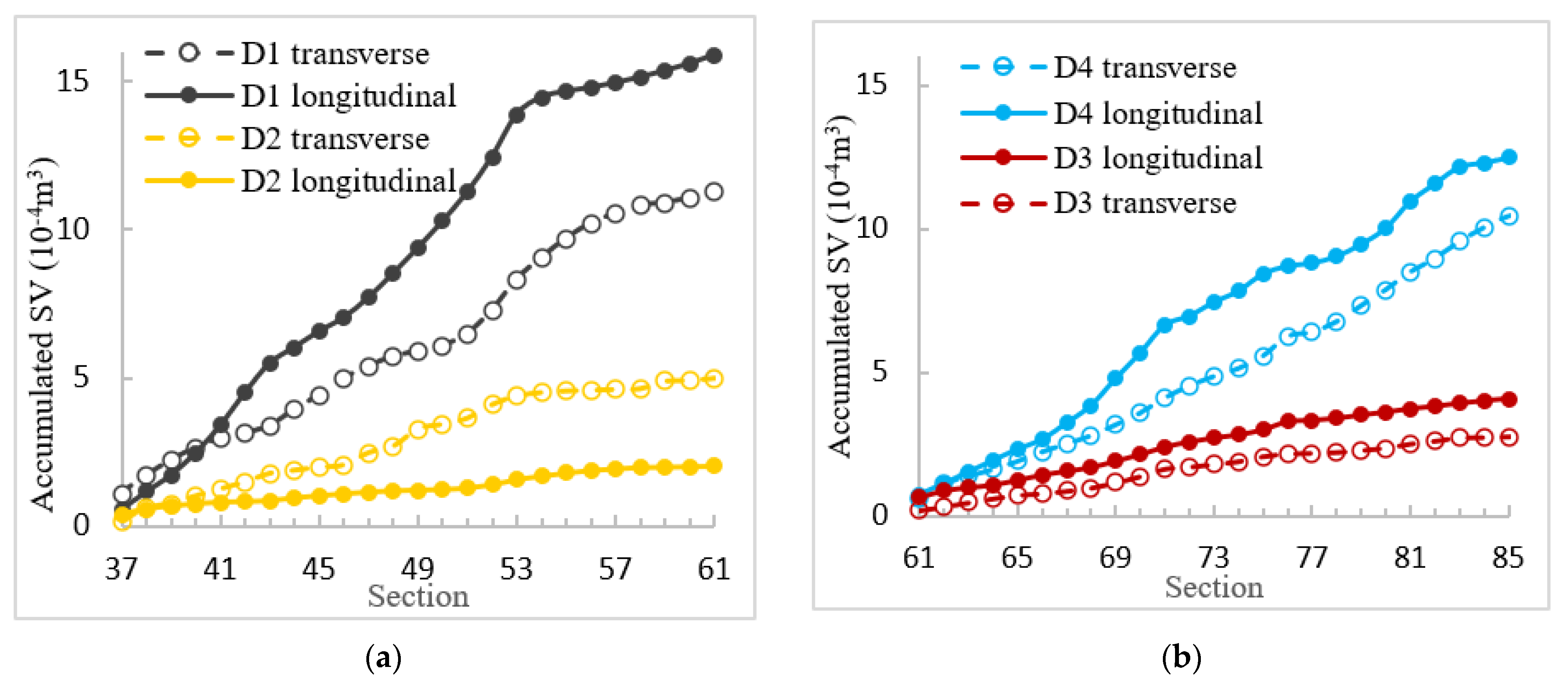
| Run | Λ(m) | λ(m) | δ | Q (m3 h−1) | B (cm) | hm (cm) | B/hm | S (‰) | Um (m s−1) | Re | Fr | |
|---|---|---|---|---|---|---|---|---|---|---|---|---|
| 30° | 30/1 | 2.518 | 2.694 | 1.07 | 60 | 40 | 11.5 | 3.48 | 1.12 | 0.31 | 35,650 | 0.29 |
| 110° | 110/1 | 2.518 | 9.298 | 3.70 | 50 | 40 | 10.0 | 4.00 | 2.00 | 0.27 | 27,000 | 0.27 |
| Test Scenarios | Diameter (mm) | Manually | 5-Time Averaged Amount by Matlab | Recognition Rate (%) | Note | |||
|---|---|---|---|---|---|---|---|---|
| D1 | D2 | D3 | D4 | |||||
| T1 | 1 | 5000 | 925.8 | 942.4 | 963.4 | 964.4 | 94.90 | N/A |
| T2 | 1 | 5000 | 967.6 | 954.4 | 899.8 | 1012.8 | 95.87 | * |
| T3 | 1 | 10,000 | 1725.6 | 1861 | 1920.2 | 1794.6 | 91.27 | N/A |
| T4 | 1 | 10,000 | 1826.4 | 1895 | 1963.2 | 1944.4 | 95.36 | * |
| Bend | 30° | 110° | ||||||||
| Section | D1 | D2 | Section | D1 | D2 | |||||
| Left Bank | Right Bank | Left Bank | Right Bank | Left Bank | Right Bank | Left Bank | Right Bank | |||
| B1 | 5–13 | −3.5 | 1.0 | 0.6 | −5.5 | 13–37 | −34.9 | 9.8 | 2.6 | −18.1 |
| B2 | 13–21 | 0.9 | 0.9 | 2.9 | 2.3 | 37–61 | 15.9 | 11.3 | 5.0 | 2.0 |
| B3 | 21–29 | 0.8 | 0.4 | 0.3 | 0.8 | 61–85 | 2.7 | 2.4 | 0.2 | 0.2 |
| Bend | 30° | 110° | ||||||||
| Section | D3 | D4 | Section | D3 | D4 | |||||
| Left Bank | Right Bank | Left Bank | Right Bank | Left Bank | Right Bank | Left Bank | Right Bank | |||
| B2 | 13–21 | −5.2 | 0.5 | 0.6 | −3.1 | 37–61 | −14.0 | 11.3 | 5.0 | 2.0 |
| B3 | 21–29 | 2.7 | 0.5 | 1.2 | 0.7 | 61–85 | 4.1 | 2.8 | 10.4 | 12.5 |
| Bend | Section | Volume of the Sand Bar (×10−4 m3) | Proportions of D1–D4 (%) | |||
|---|---|---|---|---|---|---|
| D1 | D2 | D3 * | D4 | |||
| B2, 30° flume | 13–21 (Left bank) | 1.44 | 20.5 | 66.1 | -- | 13.4 |
| B2, 110° flume | 37–61 (Left bank) | 13.60 | 56.8 | 17.9 | -- | 25.4 |
Publisher’s Note: MDPI stays neutral with regard to jurisdictional claims in published maps and institutional affiliations. |
© 2021 by the authors. Licensee MDPI, Basel, Switzerland. This article is an open access article distributed under the terms and conditions of the Creative Commons Attribution (CC BY) license (https://creativecommons.org/licenses/by/4.0/).
Share and Cite
He, L.; Chen, D.; Termini, D.; Zhang, S.; Zhu, Z. Experiments on Longitudinal and Transverse Bedload Transport in Sine-Generated Meandering Channels. Appl. Sci. 2021, 11, 6560. https://doi.org/10.3390/app11146560
He L, Chen D, Termini D, Zhang S, Zhu Z. Experiments on Longitudinal and Transverse Bedload Transport in Sine-Generated Meandering Channels. Applied Sciences. 2021; 11(14):6560. https://doi.org/10.3390/app11146560
Chicago/Turabian StyleHe, Li, Dong Chen, Donatella Termini, Shiyan Zhang, and Zhenhui Zhu. 2021. "Experiments on Longitudinal and Transverse Bedload Transport in Sine-Generated Meandering Channels" Applied Sciences 11, no. 14: 6560. https://doi.org/10.3390/app11146560
APA StyleHe, L., Chen, D., Termini, D., Zhang, S., & Zhu, Z. (2021). Experiments on Longitudinal and Transverse Bedload Transport in Sine-Generated Meandering Channels. Applied Sciences, 11(14), 6560. https://doi.org/10.3390/app11146560







